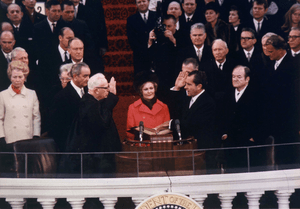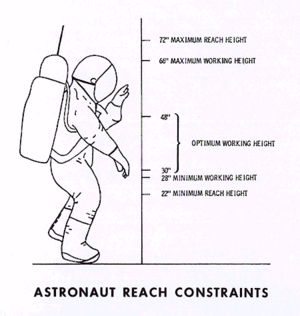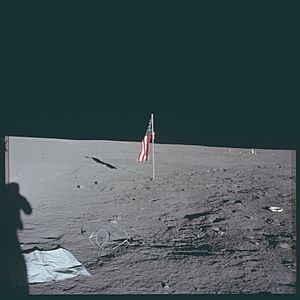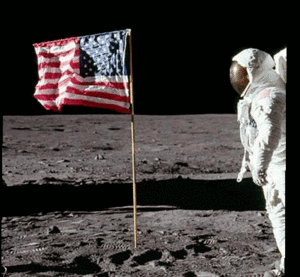Lunar Flag Assembly facts for kids

The Lunar Flag Assembly (LFA) was a special kit. It held a flag of the United States that astronauts would put up on the Moon. This happened during the Apollo program. Six of these flag kits were used on the Moon. The flags were made of nylon. They were attached to poles that could extend, like a telescope. These poles were made of strong, lightweight anodized aluminum tubes.
Most flags traveled outside the Apollo Lunar Module (LM). They were kept in a special case on the descent ladder. This case protected them from the extreme heat of the rocket exhaust. The whole assembly was designed by Jack Kinzler. He was a technical expert at the Manned Spacecraft Center in Houston, Texas. Most flags were about 3 by 5 feet. The last one planted on the Moon was a bit bigger, about 6 feet wide. It had hung in the Mission Control Room for a long time.
Contents
Why Plant a Flag?
In 1961, President John F. Kennedy set a goal. He wanted to land a person on the Moon and bring them back safely. By 1969, the Apollo program was close to achieving this. President Richard Nixon spoke about space exploration in his speech. He said we should explore space "as a new adventure to be shared."
This idea made NASA think about putting a flag on the Moon. At first, some thought about a United Nations flag. But most people at NASA and the American public wanted an American flag. Deke Slayton, a NASA manager, agreed. He said symbolic items were fine if they didn't affect astronaut training or weigh too much.
A special group was formed called the Committee on Symbolic Activities. They had to choose what to leave on the Moon. They also decided what to bring back. The committee wanted to show that the Moon landing was a big step for all people. But they also wanted to show it was achieved by the United States. They also made sure it didn't look like the U.S. was claiming the Moon. This was important because of the Outer Space Treaty of 1967.
Many people suggested planting a flag. The committee decided to plant the U.S. flag. They also suggested putting a plaque on the lunar module. This plaque would say: "Here men from the planet Earth first set foot upon the Moon July 1969, A.D. We came in peace for all mankind."
Some people worried that planting a U.S. flag might seem like the U.S. was claiming the Moon. But the U.S. made it clear it wasn't. So, there wasn't a big problem. Later, in November 1969, the United States Congress passed a law. It said only the U.S. flag should be placed on the Moon by U.S. missions. This was a symbol of national pride, not a claim of ownership.
How the Flag Was Designed
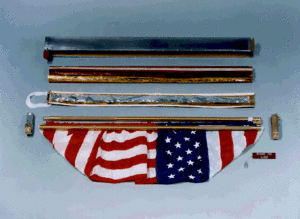
About three months before the Apollo 11 mission in July 1969, NASA needed someone to design the flag assembly. Robert Gilruth, a director at NASA, asked Jack Kinzler to do it. Kinzler was known as "Mr. Fix It." He got the idea from watching his mother hang curtains. He thought of putting a horizontal pole through the top of the flag. This would make the flag look like it was flying, even though there's no wind on the Moon. He worked out the details with his team. Kinzler also helped design the lunar plaques for the lunar modules.
The flag itself was a simple nylon flag, about 3 by 5 feet. It was bought from a government store. The only change was sewing a pocket for the horizontal pole. But how to pack it, protect it from space, and set it up was tricky. The poles were made of one-inch aluminum tubes. They could slide into each other to extend. Astronauts wore thick spacesuits, so their movement was limited. The flagpole's height was set to fit their reach. The flag cost $5.50, and the tubing cost $75.
There's some debate about who made the flags. Annin & Co. is often named, but labels were removed from the flags. This was done to make them easier to attach to the poles. So, it's hard to be completely sure.
The flag assembly had to be designed for astronauts in their bulky spacesuits. They had limited movement and couldn't use their hands easily. The design made sure they could still set up the flag.
The flag assembly was stored behind the ladder of the lunar module. The rocket engine's exhaust got very hot, up to 2000°F (1093°C) during landing. To protect the flag, it was packed in a special case. This case had layers of stainless steel, aluminum, and special insulation. This kept the flag safe from the extreme heat. The case itself cost several hundred dollars. For the last three Moon landings, the flags were stored in a different place. They were in the Modular Equipment Stowage Assembly (MESA). This was a drawer on the side of the lunar module. This new spot meant they didn't need the special heat protection case.
The whole flag package needed to be very light. It weighed about 9 pounds, 7 ounces (4.28 kg). This was important so it didn't take up too much weight that could be used for other things.
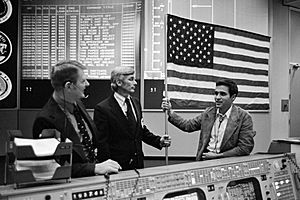
The flag used on the final mission, Apollo 17, was special. It had hung in the Mission Control Room during earlier Apollo landings. This flag was a bit wider and taller than the others. So, it needed a 6-foot-long horizontal pole. Astronauts Gene Cernan and Harrison Schmitt also took a second, identical flag to the Moon and back. They gave it to flight controller Gene Kranz. This was to replace the one left on the Moon.
Flags Planted on the Moon
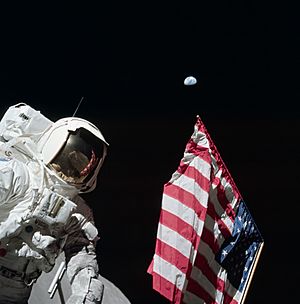
A flag was planted on every Apollo mission that landed on the Moon. Setting up the flag during the Apollo 11 mission was hard. Neil Armstrong and Buzz Aldrin had trouble pushing the pole into the Moon's surface. They only got it about seven inches deep. But it stood up on its own. Scientists later found out that Moon dust is different from Earth dust. Moon dust has sharp edges, which makes it stick together. This makes it hard to push things into it.
Buzz Aldrin said the Apollo 11 flag fell over when the rocket took off. It was placed about 27 feet from the landing craft. Because of this, later crews placed their flags farther away from the lunar module.
Pete Conrad and Alan Bean on Apollo 12 had a problem. The latch that held the horizontal pole straight didn't work right. So, their flag drooped at an angle. After this, the flag assembly was improved. It got a double-latch system for future missions.
The Apollo 13 mission did not land on the Moon. There was a big problem with the spacecraft before it reached the Moon. The flag for Apollo 13 was stored outside the lunar module. It was destroyed when the lunar module burned up entering Earth's atmosphere.
On Apollo 15, the flag was planted later than planned. Astronauts David Scott and James Irwin had practiced how to set up the flag. They also practiced how to position themselves and the Lunar Roving Vehicle for the best photos.
The flag from Apollo 17 has a unique story. It had traveled to the Moon and back on Apollo 11. After that, it hung in Mission Control. On the first day of the Apollo 17 mission, Gene Cernan put it up in the Taurus–Littrow lunar valley. As he did it, Cernan said it was one of the proudest moments of his life.
What Happened to the Flags?
The nylon flags were bought from a regular government store. They were not made to last in the harsh conditions of space. Some experts think the flags' colors might have faded to white. This could be from sunlight and space radiation. Or the fabric might have broken down completely.
However, photos from the Lunar Reconnaissance Orbiter (LRO) show something interesting. As of 2012, flags from the Apollo 12, 16, and 17 missions were still standing. The LRO cameras can see shadows from the flag fabric. This means the flags didn't completely disappear.
A look at the Apollo 11 site photos shows that Aldrin was likely right. The flag probably fell over. No flag was seen in those images. As of 2012, experts couldn't tell if the Apollo 14 and 15 flags were still standing.
Flag Conspiracy Theories
Some people claim that the Moon landings were faked. One reason they give is that the flag seems to move in photos. They say this proves the videos were shot on Earth, where there is wind.
But NASA knew there was no wind on the Moon. That's why they designed the flag with a horizontal pole. This pole was supposed to keep the flag spread out. For the Apollo 11 flag, this horizontal pole got stuck. This caused the flag to have wrinkles. These wrinkles made it look like it was moving in still pictures. Also, when the astronauts were setting up the flag, their movements made it ripple.
See also
 In Spanish: Montura de la Bandera Lunar para niños
In Spanish: Montura de la Bandera Lunar para niños


